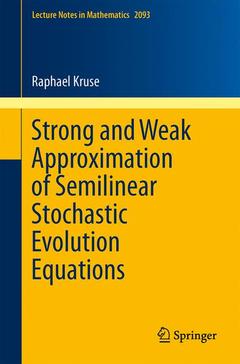Description
Strong and Weak Approximation of Semilinear Stochastic Evolution Equations, 2014
Lecture Notes in Mathematics Series, Vol. 2093
Author: Kruse Raphael
Language: English
Subjects for Strong and Weak Approximation of Semilinear Stochastic...:
Approximative price 36.91 €
In Print (Delivery period: 15 days).
Add to cart177 p. · 15.5x23.5 cm · Paperback
Description
/li>Contents
/li>Comment
/li>
In this book we analyze the error caused by numerical schemes for the approximation of semilinear stochastic evolution equations (SEEq) in a Hilbert space-valued setting. The numerical schemes considered combine Galerkin finite element methods with Euler-type temporal approximations. Starting from a precise analysis of the spatio-temporal regularity of the mild solution to the SEEq, we derive and prove optimal error estimates of the strong error of convergence in the first part of the book.
The second part deals with a new approach to the so-called weak error of convergence, which measures the distance between the law of the numerical solution and the law of the exact solution. This approach is based on Bismut?s integration by parts formula and the Malliavin calculus for infinite dimensional stochastic processes. These techniques are developed and explained in a separate chapter, before the weak convergence is proven for linear SEEq.
Introduction.- Stochastic Evolution Equations in Hilbert Spaces.- Optimal Strong Error Estimates for Galerkin Finite Element Methods.- A Short Review of the Malliavin Calculus in Hilbert Spaces.- A Malliavin Calculus Approach to Weak Convergence.- Numerical Experiments.- Some Useful Variations of Gronwall’s Lemma.- Results on Semigroups and their Infinitesimal Generators.- A Generalized Version of Lebesgue’s Theorem.- References.- Index.
Employing Galerkin finite element methods closes the gap between theoretical convergence results and standard PDE solvers in widely used software packages
Derives the optimal order of strong convergence through optimal regularity results
Includes a self-contained introduction to Malliavin calculus
Effectively approaches weak convergence for SPDEs with stochastic coefficients by avoiding Kolmogorov’s backward equation
Includes supplementary material: sn.pub/extras

